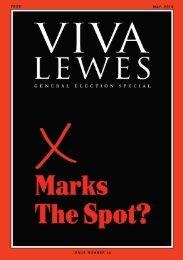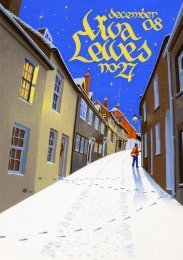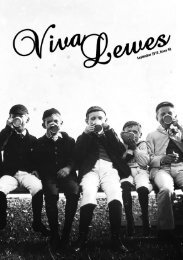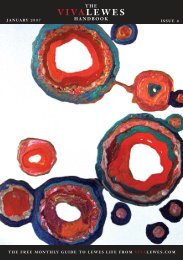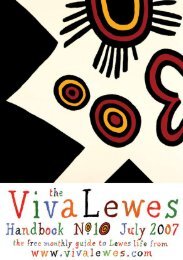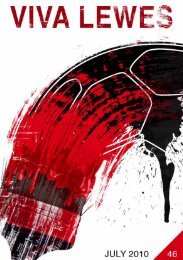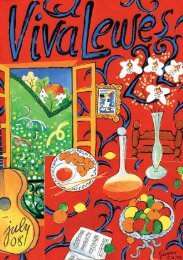Create successful ePaper yourself
Turn your PDF publications into a flip-book with our unique Google optimized e-Paper software.
W W W. V i Va L E W E s . C o M<br />
riverside<br />
It’s just a rumour that was spread around town<br />
It is commonly thought that the Riverside Centre<br />
was built as Albion Russell’s shoe factory. That<br />
Russell’s business boomed to become the national<br />
retail chain Russell and Bromley. We like it when<br />
little old <strong>Lewes</strong> ‘punches above its weight’ like this,<br />
but we also thought the Riverside would be a good<br />
fit this month, because its past reflects the rise of the<br />
motoring age.<br />
In 1905, it was home to Ouse Engineering Works, an<br />
iron foundry that diversified into the field of ‘steam<br />
road cars’ and motor repairs. Until the 40s it was<br />
Martin’s Garage, where ‘bodies were first fitted to<br />
Model T Ford cars’. Then it housed Becks Hire Cars.<br />
But after a little digging, we were diverted from our<br />
theme by the discovery that the origins of the Riverside<br />
aren’t so clear. In fact, even after a good few<br />
days with our noses buried in dusty documents, we<br />
found no precise date of the build, nor any evidence<br />
of a connection with Mr Russell. Thankfully for us<br />
though, we did find plentiful tales of booze, madness,<br />
enterprise and loss…<br />
As far back as 1620, the area was part of a grand<br />
estate known as Bridgefoot, comprising a manor,<br />
coalyard, wharf and four acres. It was the home of a<br />
string of highly successful merchants, and a couple<br />
who were not so successful. Richard Cardin, shipper<br />
of arms and wine to ports as far off as Barbados, fled<br />
to London after his business collapsed and fire ravaged<br />
his property. His successor also went bankrupt.<br />
In 1833, the wealthy Quaker Burwood Godlee<br />
purchased a wharf, warehouse, counting house and<br />
outbuildings, of which we think the Riverside was<br />
b r i c k s & m o r t a r<br />
part. Godlee was a master of local ventures on the<br />
grandest scale. He built and launched a 120-tonne<br />
seagoing ship, The <strong>Lewes</strong> Castle, on the banks of<br />
the Ouse, and also constructed a drawbridge across<br />
the river.<br />
It is quite probable that after his grand ideas had<br />
been realised Godlee remained landlord until his<br />
death in 1882. We do know, at least, that <strong>Lewes</strong><br />
Wharf was in use by a timber merchant in 1839, and<br />
that there was a ‘carpenter’s shop and store’ on the<br />
site in 1856.<br />
Until c.1887 the Riverside site was occupied by<br />
CA Wells of Etna Iron Works. Wells acquired<br />
the property in 1869, fully kitted with gas works,<br />
engine room, boiler house, smiths’ and fitter’s shops,<br />
a pattern loft, lathe room and foundry. His poor<br />
predecessor, an iron founder named Henry Attwood<br />
Thompson, went mad after only two years at the<br />
property, which his executors sold.<br />
Albion Russell did build his business from <strong>Lewes</strong>.<br />
He acquired 187/88 High Street (now Tourist Info)<br />
and two cottages behind in 1861 and stayed for<br />
many years. Before that, his workshops were behind<br />
Baxter’s at No. 37. And it was from here that he<br />
secured lucrative contracts with <strong>Lewes</strong> gaol during<br />
the Crimean War.<br />
In the directories, however, there is only one<br />
mention of Russell at a loose address. In 1895, he’s<br />
listed as Honorable Secretary of the Ouse Angling<br />
Preservation Society, ‘High St’… but that’s not quite<br />
evidence of the grand factory master...<br />
Chloë King<br />
illustration by: Lyndsey smith<br />
6 1



